The Art of Healing
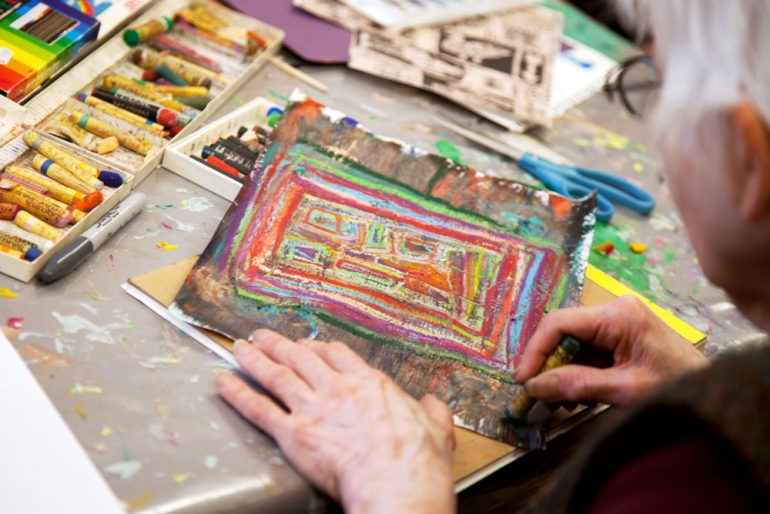
The idea of art as medicine dates back to antiquity, but recently the concept is drawing increasing interest from the medical and science communities.
Seated at a table dotted with paintbrushes, pencils and curios, Hideka Suzuki is creating an abstract on a small canvas. It’s not an idle craft project; for her, it’s a form of therapy.
“Sometimes I don’t even know what I’m thinking until I sit down and start drawing. Then my feelings come out on paper,” said Suzuki, a teacher in remission from uterine cancer.
She’s a participant at Art for Recovery, a pioneering program at the UCSF Helen Diller Family Comprehensive Cancer Center that has brought patients together since 1988 under the philosophy that creating art – no skills required – has a central role in healing.
It’s hard to empirically measure that impact because so many of art’s benefits are indirect, said Theresa Allison, MD, PhD, an associate professor in the UCSF Division of Geriatrics who has a background in musical anthropology. But, she said, therapies that benefit a patient’s emotional wellbeing can have real impact on overall health.
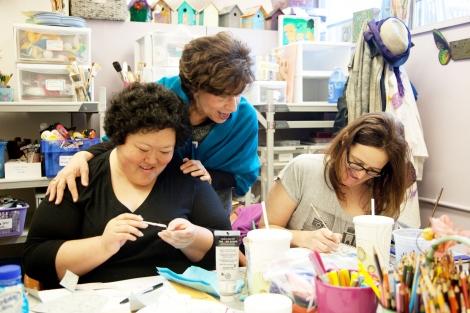
Art for Recovery director Cindy Perlis, center, works with Hideka Suzuki, left, and Sylvia Parisotta, right, as they get creative during a program gathering at UCSF's Mount Zion campus on Nov. 12. Photo by Cindy Chew
“We are finally at a tipping point, where the health sciences recognize the impact of loneliness and depression on health care outcomes, and we recognize the positive impact of visual and performing arts on symptoms management,” Allison said.
“Now we’re starting to ask why, and to bring in the science to study art’s impact. National funding agencies are starting to support this, and we’re going to see a lot of research emerge in upcoming years.”
Over the last few decades, a growing body of studies and anecdotal evidence suggesting that art is healing have driven the incorporation of art into medical settings. Nearly half of the health care institutions in the United States reported including arts in health care programming, ranging from art and music therapy to featuring visual art in hospitals.
“It’s a huge opportunity to think about using different modes of healing,” said Julene Johnson, PhD, a cognitive neuroscientist and professor at the UCSF Institute for Health & Aging. She’s running a study measuring the health impacts of singing in a choir. “The nice thing about the arts is our long, long history of using music and arts for healing across thousands of years, and the fact that it’s relatively low cost to implement.”
A History of Healing Influence
A landmark 1984 study published in Science found that patients recovering from gall bladder surgery recovered more quickly if they were in hospital rooms with a view of trees, as compared to a view of only a brick wall.
The patients were in the same suburban hospital with the same nurses in rooms that were close to identical, but those who could view nature required less potent painkillers and had shorter postoperative stays.
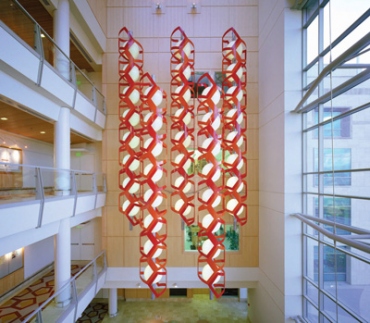
Art and Science Intertwined at UCSF
In 1999, as the Mission Bay campus took its first steps from vision to reality, then-Chancellor Mike Bishop pledged 1 percent of campus construction costs to establish initial funding for a public art program. The chancellor's pledge followed UCSF's longstanding commitment to enrich campus life by integrating a wide range of art into public space, reflecting the diversity of the community.
This set the stage for a flurry of other research on design variables in health care settings that posed the same question: Could healing be about more than good medicine and empathetic clinicians? Not every hospital room can offer patients a bucolic view, so researchers sought to find out if art depicting a pleasing scene might deliver the same positive effects.
Indeed, multiple studies have shown that a hospital’s physical environment is much more than a backdrop for health care delivery. The presence of nature scenes and art has a measurable impact on patients’ pain levels.
For example, for about 75 percent of burn victims, painkillers fail to alleviate their pain. In a small 1992 study in the Journal of Burn Care and Research, researchers experimented with using videos of “scenic beauty” as a distraction technique. Patients with severe burns reported lower pain intensity during dressing changes when shown the beautiful videos in addition to their medication.
Likewise, a 2003 study out of Johns Hopkins University found that nature scene murals displayed by the bedside reduced pain for patients undergoing bronchoscopy, a procedure in which a narrow tube with a scope is passed from the nose or mouth into the airways.
Hospitals across the country are increasingly acting on these findings.
At the UCSF Medical Center at Mission Bay, art plays a central role in the design of the new cancer, women’s and children’s hospitals. In addition to art sculptures, paintings and interactive pieces featured throughout the complex, patient rooms include views of rooftop gardens or the San Francisco Bay, and scan rooms are equipped with screens displaying calming nature scenes.
“We wanted art to be integrated into the fabric of our new facilities in a way that reinforced the healing environment that we were creating,” said Cindy Lima, executive director of UCSF Mission Bay Hospitals Project.
Renowned Artists Contribute to Healing Environment
The new UCSF Medical Center at Mission Bay, scheduled to open on Feb. 1, 2015, aims to provide a healing environment that features grand art installations designed to inspire patients and the public alike. Watch the stories of how these beautiful works came together.
Reducing Stress and Channeling Emotions
In addition to viewing art or nature scenes, the act of creating art has been linked to improvement in emotional wellbeing.
A 2012 study published in Stress and Health of women with breast cancer found that a mindfulness-based art therapy program helped patients reduce stress and anxiety. The study looked at the brain using MRI, and found significant changes in the cerebral blood flow in regions corresponding to reward and the regulation of stress response.
These positive neuropsychological changes were corroborated by the patients’ reporting of reduced stress. The study’s author noted that improved wellbeing is associated with improved immune function.
Suzanne Yau, an art therapist at UCSF Benioff Children’s Hospital San Francisco, believes that art is intrinsic to wellbeing for young patients as well.
“It provides opportunities for success and achievement, reduces anxiety, increases self-awareness and helps patients identify and explore their concerns,” Yau said. “Perhaps most important, it gives patients a voice when words are not accessible or simply not enough.”
Art as Caring
To Cindy Perlis, director of the UCSF Art for Recovery program, these findings are far from surprising.
She’s watched thousands of patients – most of whom have stated that they have no artistic bent – create soulful self-portraits, make fiery masks and spirit houses, embellish old shoes with dazzling finery and blend words with paint strokes to make striking visual statements. As a child, she turned to art to help her cope with the loss of her father.
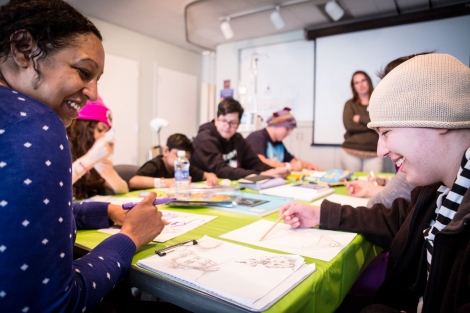
Artist Shinique Smith, left, led a workshop with pediatric patients in May where they made art and wrote poetry. She used their work as inspiration for a sprawling wall mural at the new UCSF Medical Center at Mission Bay. See the finished product here. Photo by Elisabeth Fall
At the height of the AIDS furor in the 1980s, Perlis was recruited to start Art for Recovery. She recalls caring for patients who had wasting syndrome, pneumonia and Kaposi’s sarcoma. Many were young men who had lost their partners and whose families had abandoned them.
“I was told to wear a gown, gloves and mask. I would sit on their bed and ask them to express their anger, fears, hopes and dreams. They’d put down on paper all the emotions that they couldn’t articulate. And I’d hold their hand, because no one was touching them.”
Interested in Art Therapy at UCSF?
The UCSF Helen Diller Comprehensive Cancer Center's Art for Recovery program is currently located at the Mount Zion campus, and will expand to UCSF Medical Center at Mission Bay after its opening on Feb. 1, 2015.
At the UCSF Benioff Children's Hospital San Francisco, the Child Life Services program offers art therapy for pediatric patients. When it moves to Mission Bay in February, it will also include a digital art studio and creative art studio.
“The experience made me realize that, as an artist, this is where I needed to be,” she said. “I hadn’t been able to take care of my father when he died, because I was so young, but this gave me a chance to share my own creativity and take care of other people.” Even those patients whose futures were bleak and brutally short had found “healing” when they found art, according to Perlis.
Today participants in Art for Recovery are mainly cancer patients, like Suzuki. At a recent weekly art session, she painted with her friend Sylvia Parisotto, who worked as an art conservationist until symptoms of a brain tumor impacted her fine motor skills.
Both women agreed that the program gives them free rein to express the maelstrom of emotions that they have wrestled with during diagnosis and treatment.
“The truth comes out when I’m painting,” said Parisotto, who is currently brain tumor-free but not classified as being in remission. “Art is a vehicle to express my innermost thoughts and fears.”
With artistic expression, comes an easy camaraderie among participants, men and women from diverse backgrounds united by complex medical regimens of scans, surgeries and chemo infusions.
“It can be hard to connect with people who don’t have cancer,” said Parisotto. “They might be very guarded or they might dismiss our concerns with a ‘You’ll be fine.’”
Healing the Whole Person
Many of the benefits patients find in art are intangible, but they are real.
“I think the beauty of the arts is that they are whole person engagements,” Allison said. “When we are looking at a painting, singing in a choir, or going to the theater, we’re engaging not just our intellect but our hearts, and in that moment of being transported by the artistic experience, this is a whole person experience.”
As art therapy gains traction in the medical world, more studies are looking at how emotional benefits of art are translating to other health improvements.
“We’re a long way away from being able to prescribe music or art like we would a medication,” said Allison.
The connection between art and healing in the body are “complicated relationships,” she said. “But one day I think what may find ourselves doing is prescribing music the way we prescribe exercise or other behavioral intervention.”
Take a tour of the art installations at the new UCSF Medical Center at Mission Bay, which will feature works by renowned artists Spencer Finch, Ranjani Shettar, Barry McGee, Shinique Smith and many others.
Related Links
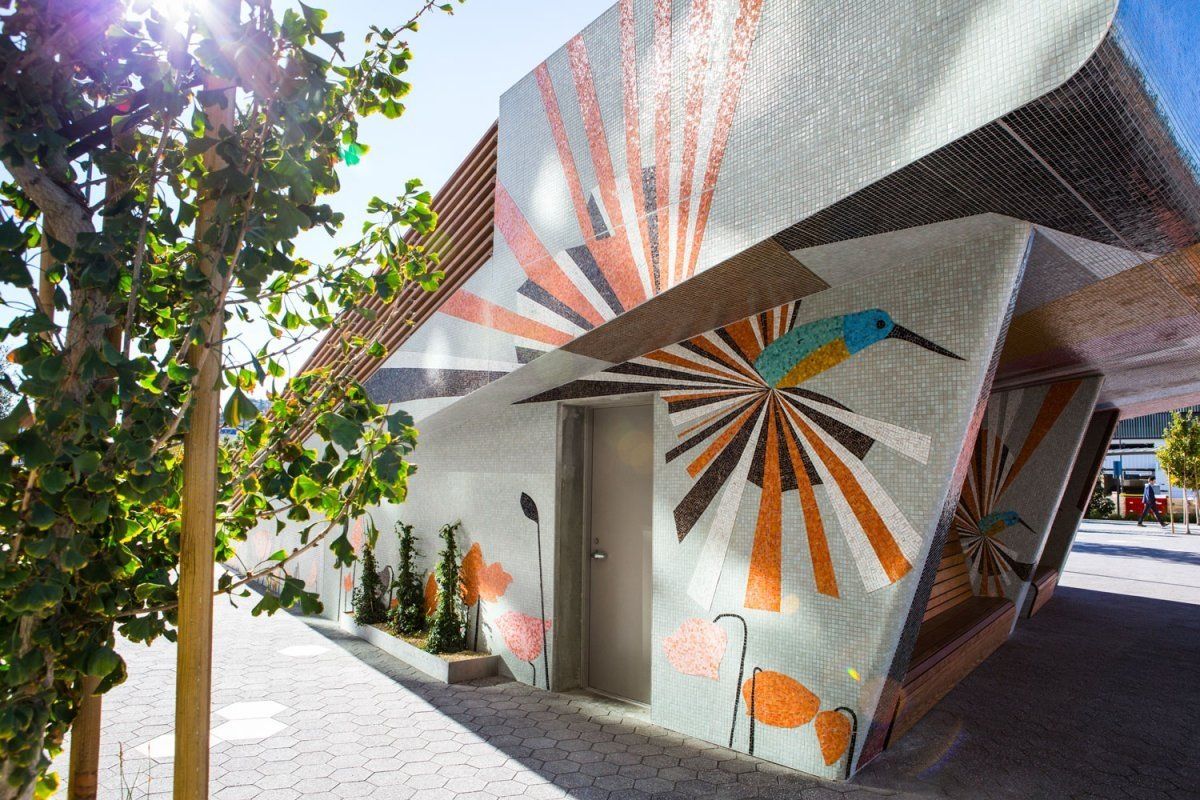
Bay Area-based artist Clare Rojas designed the public amphitheater in front of the UCSF Medical Center at Mission Bay with a mosaic of vivid, geometric shapes featuring hummingbirds. To her, the hummingbird is a symbol of regeneration and love. Photo by Elisabeth Fall
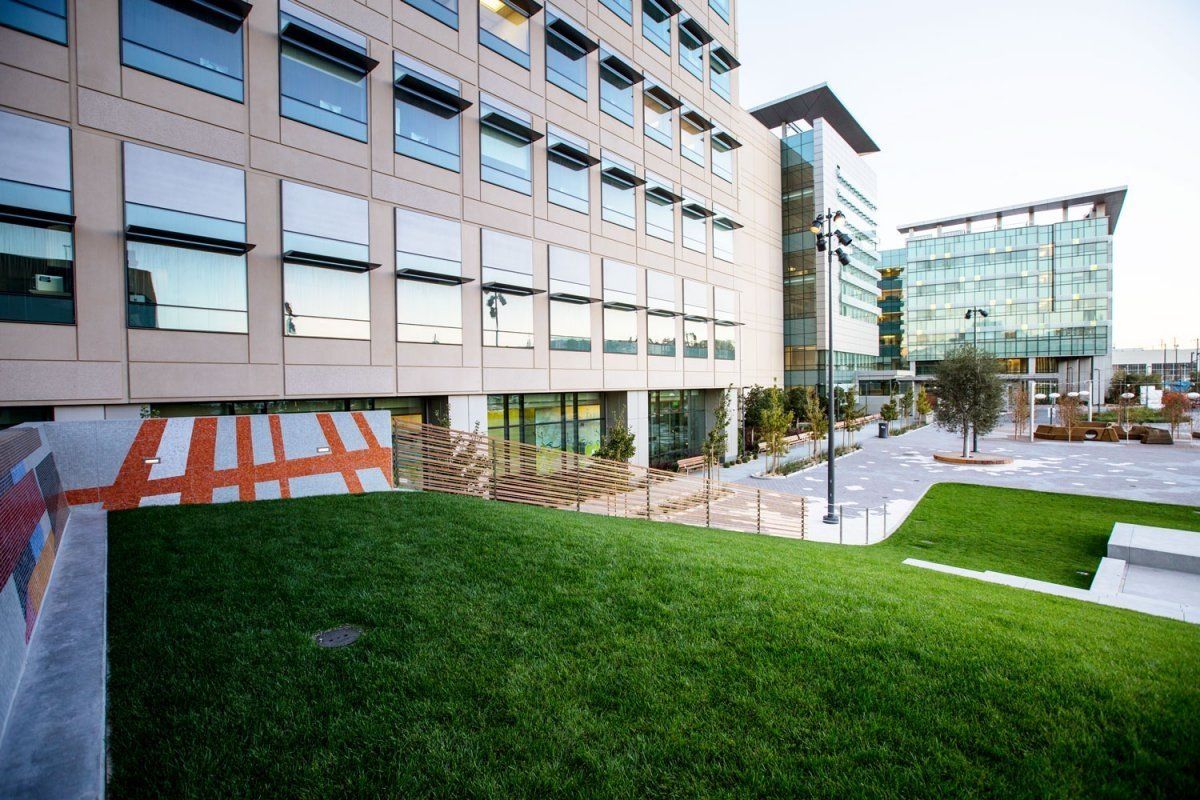
The colorful amphitheater anchors the Fourth Street Public Plaza and will host performances and other outdoor events on the green. Photo by Elisabeth Fall
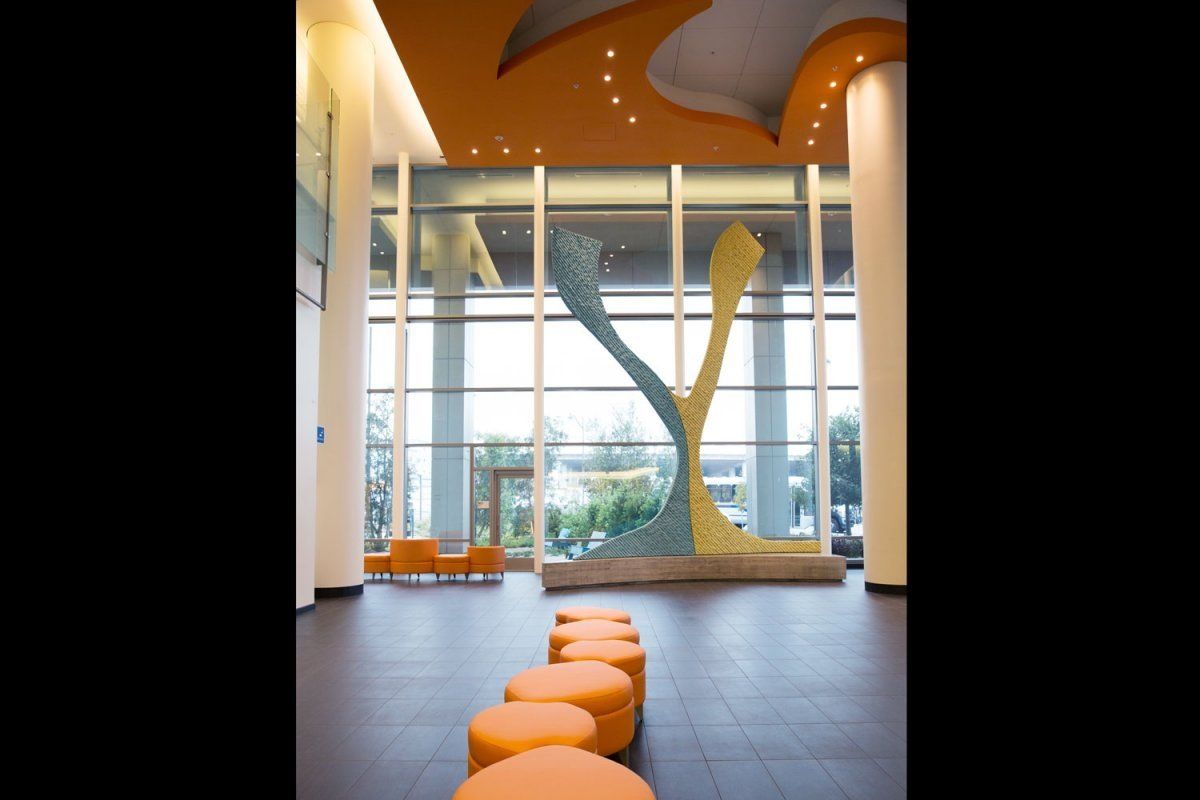
Jessica Stockholder's installation includes six pieces together called “Like Water if Pond as Lily.” The element high on the ceiling of the two-story lobby "expands the scale of the work, echoing the shapes already seen on the way in, and reiterates again that shifting points of view are always possible,” she explained. Photo by Elisabeth Fall
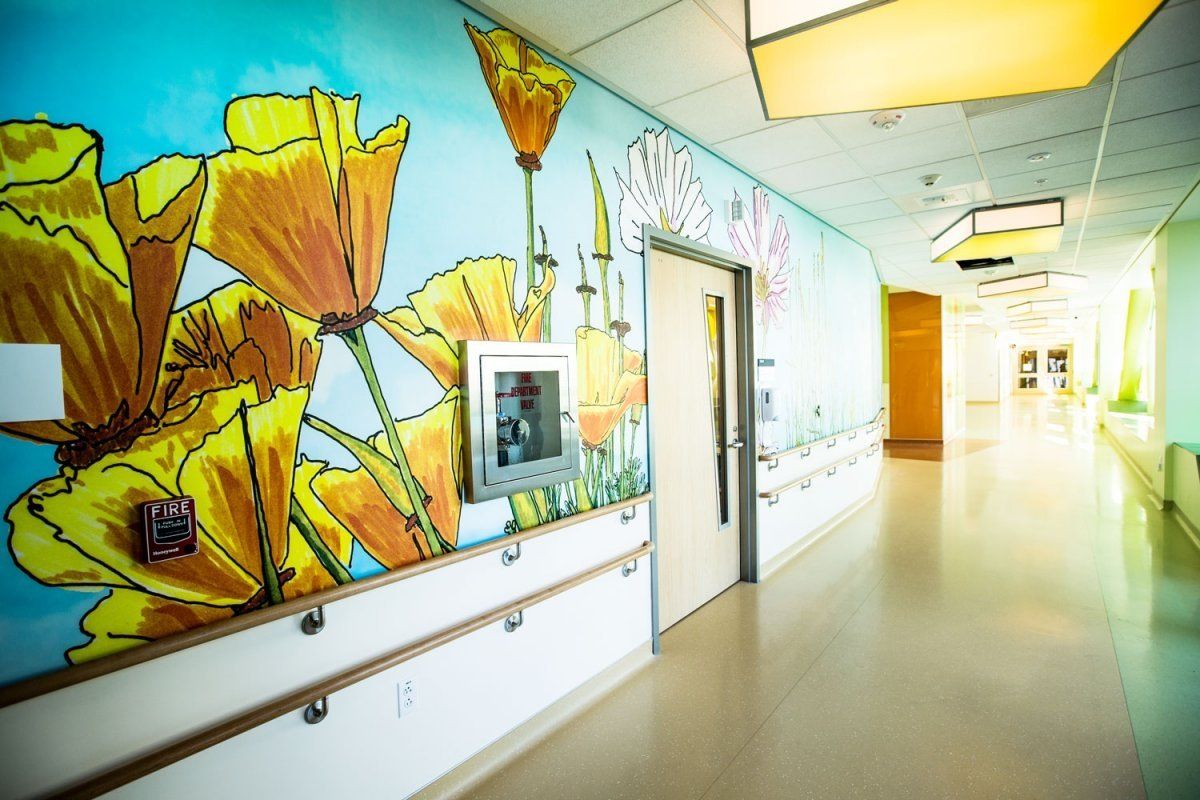
Los Angeles-based artist Dave Muller painted intricate flowers and nature scenes on multiple floors of the Children's Hospital. Photos by Elisabeth Fall
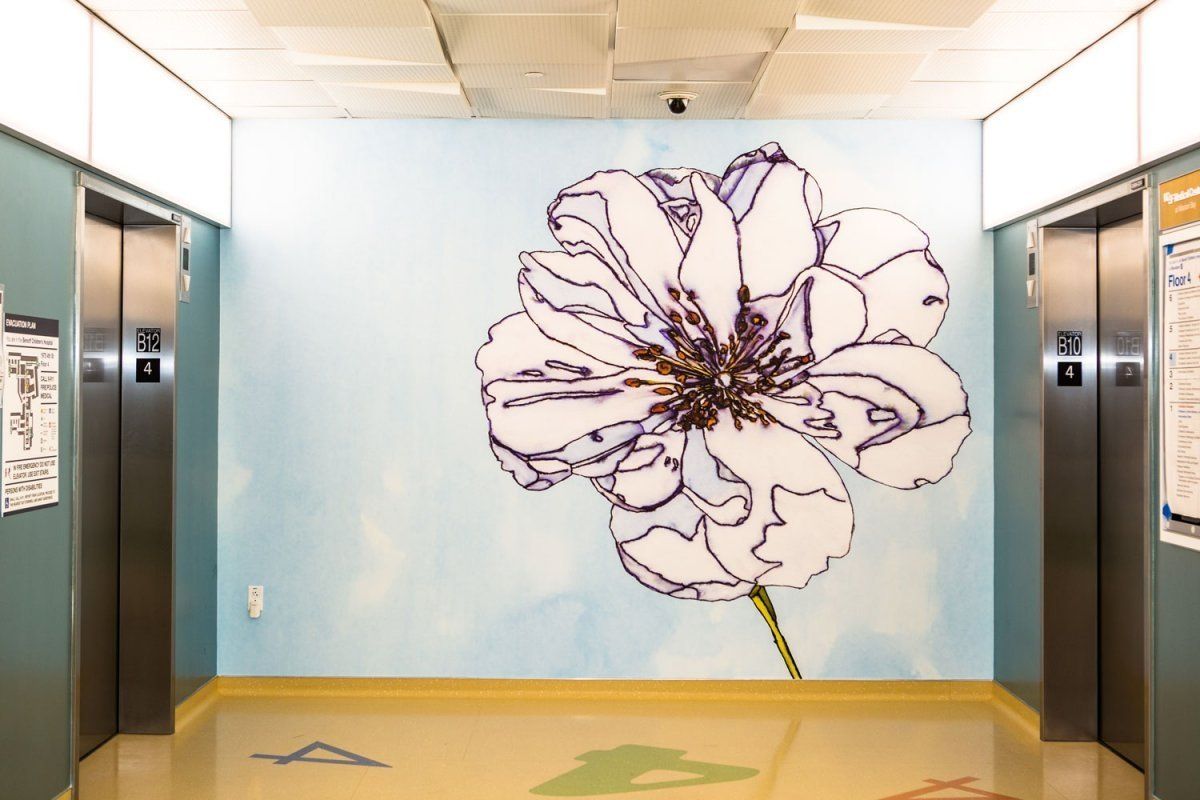
Dave Muller says he chose to put his art in unexpected places so patients coming to the hospital frequently can see something new each time:"You discover treasure. It leads to more treasure and soon you are looking for it everywhere." Photo by Elisabeth Fall
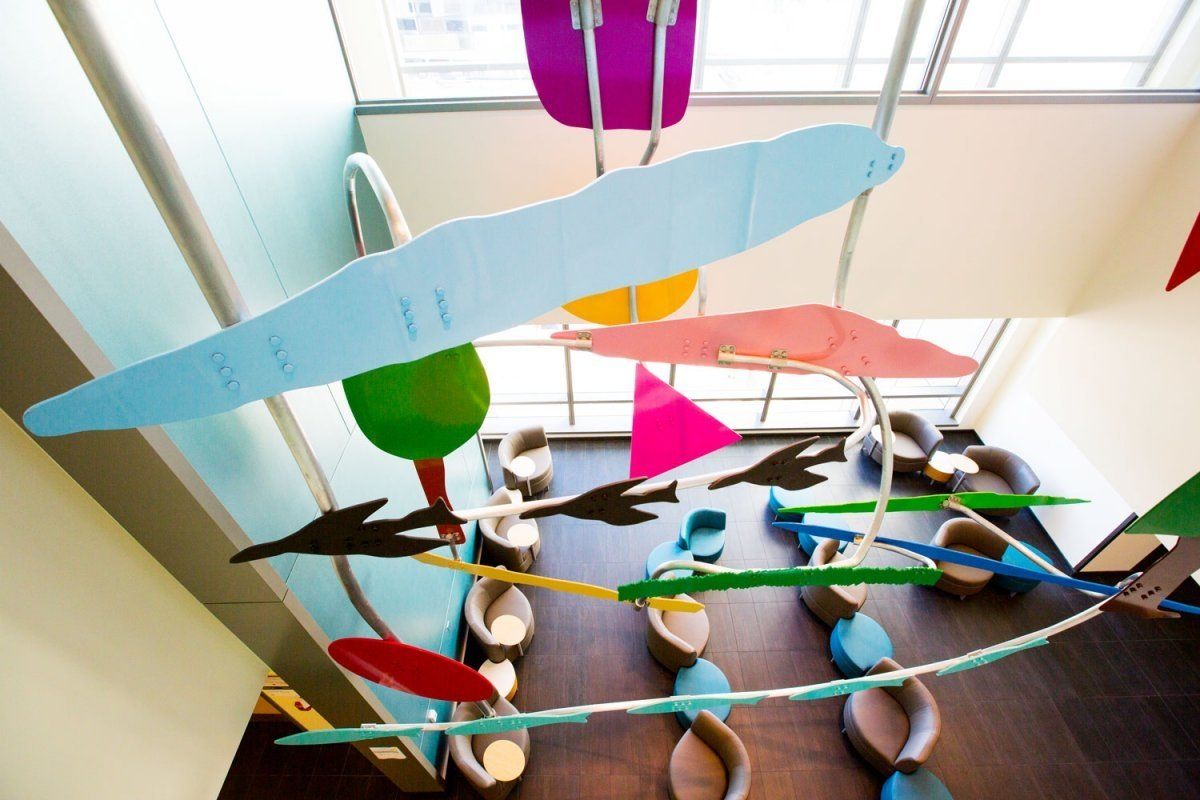
Los Angeles-based artist Chris Johanson assembled colorful nature-inspired shapes to create a stainless steel sculpture that is "philosophical, quiet and promoting well-being by showing our connectedness to nature and the whole of life.” Photo by Elisabeth Fall
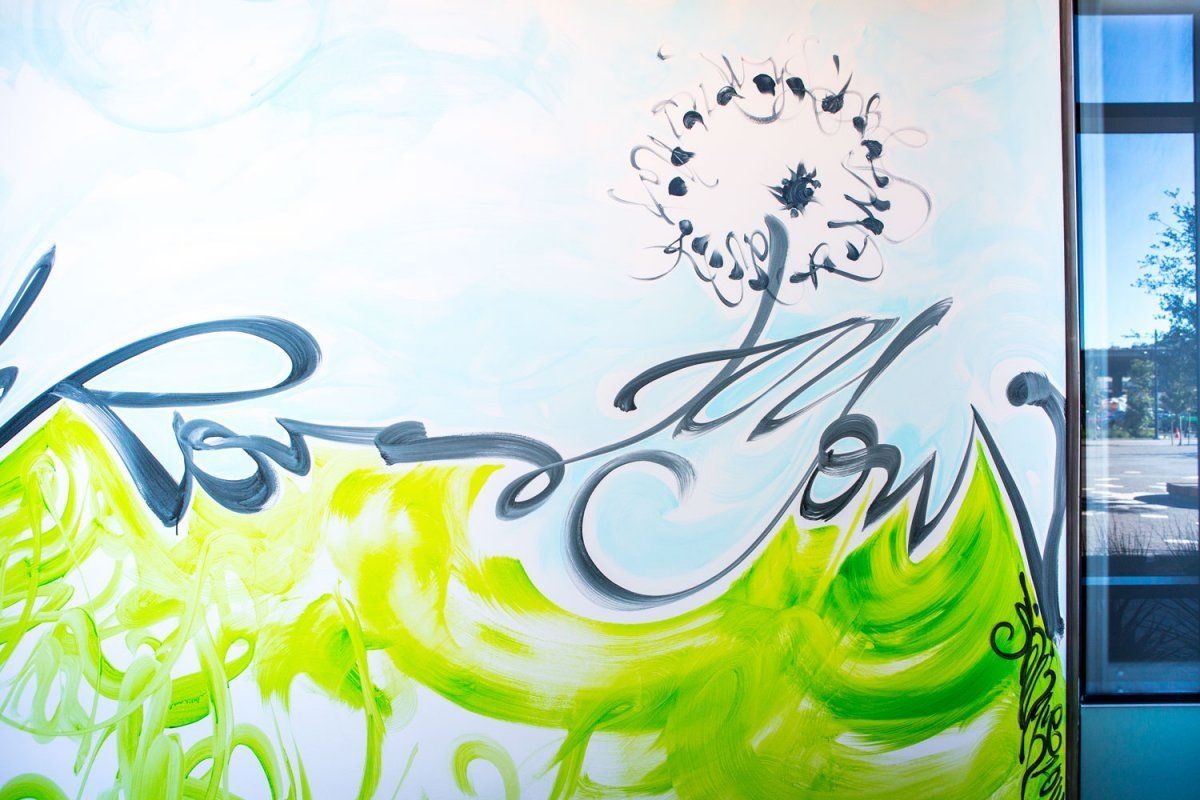
New York-based artist Shinique Smith held poetry workshops with UCSF pediatric patients and interpreted their inspiring words into an expansive wall mural in a first-floor corridor of the medical center. Photo by Elisabeth Fall
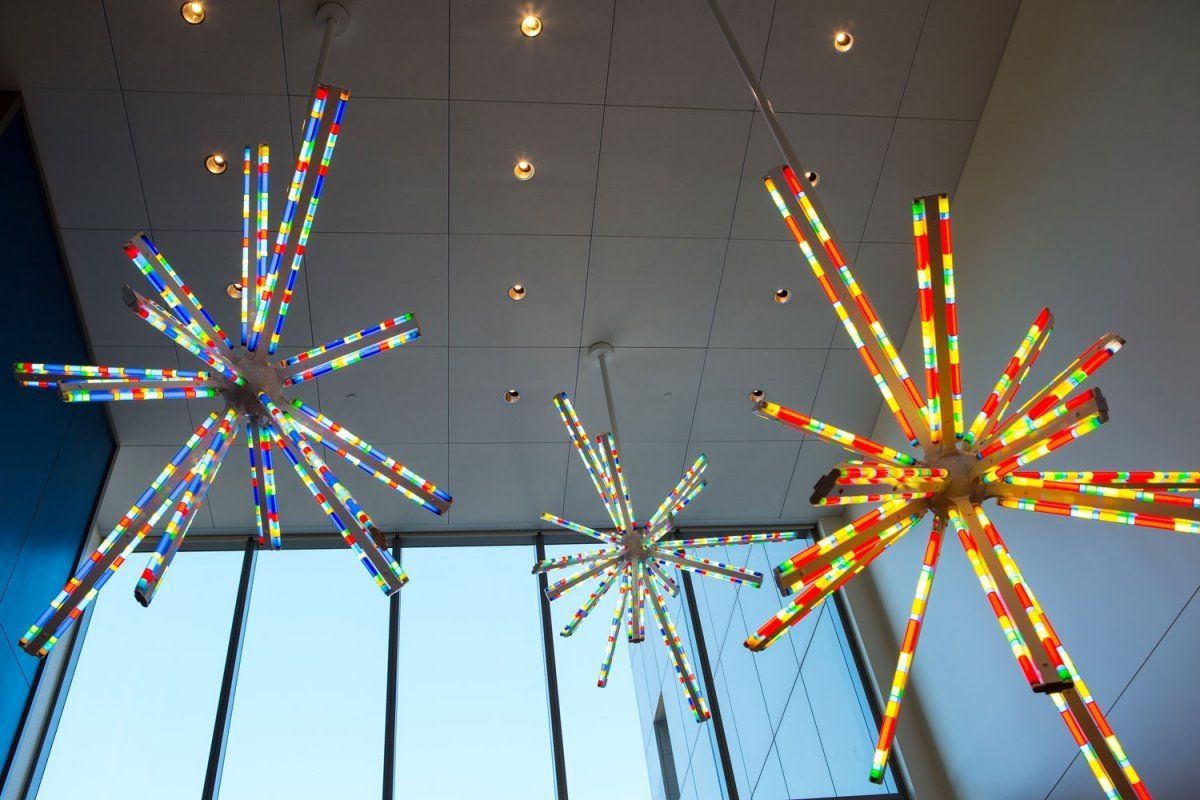
Brooklyn-based artist Spencer Finch, recently renowned for his installation at the National September 11 Memorial Museum, created three colored lamp sculptures that hang over an entrance of the adult hospital. Each sculpture represents a star in the constellation Ophiucus, named for the Greek god of healing and medicine. Photo by Elisabeth Fall
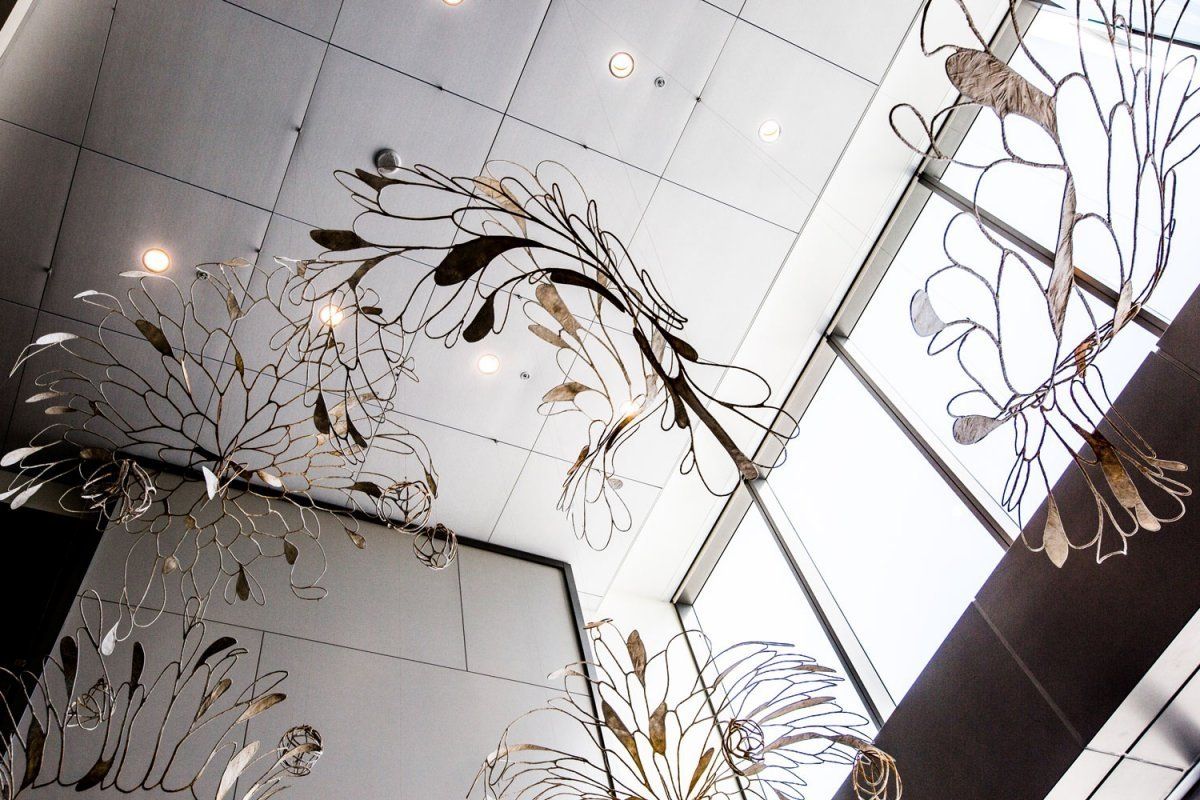
Bangalore-based artist Ranjani Shettar, whose work is in the collection of the San Francisco Museum of Modern Art, created whimsical mobiles that float over one of the lobby waiting rooms of the UCSF Betty Irene Moore Women's Hospital. Photo by Elisabeth Fall
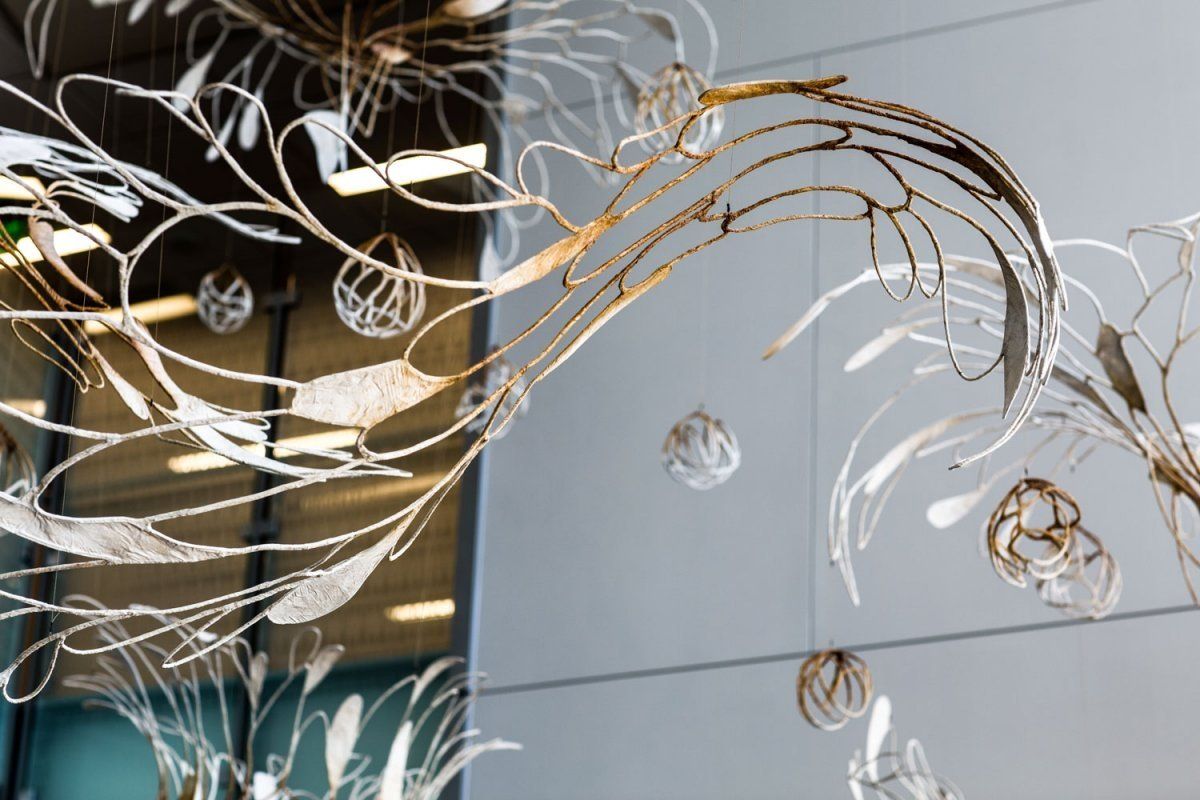
Ranjani Shettar's mobiles, made of stainless steel wrapped in muslin, tamarind and acrylic, cast unique shadows throughout the lobby as the sun moves through the sky. “Light can be very magical," she says. "I am constantly playing with illusion – the object of something and looks like something else.” Photo by Elisabeth Fall
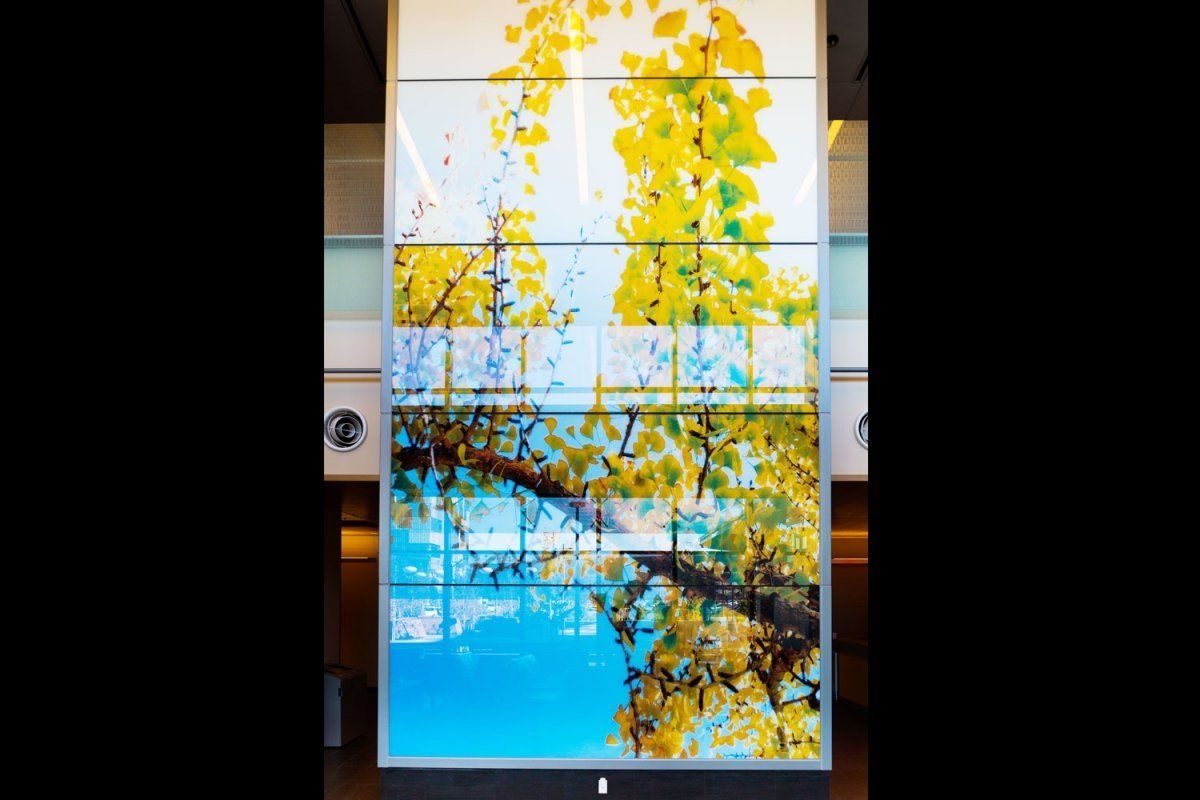
In the lobby of the Women's and Cancer hospitals, Berkeley-based artist Nina Zurier created a two-story glass installation depicting a ginkgo biloba tree. Photo by Elisabeth Fall
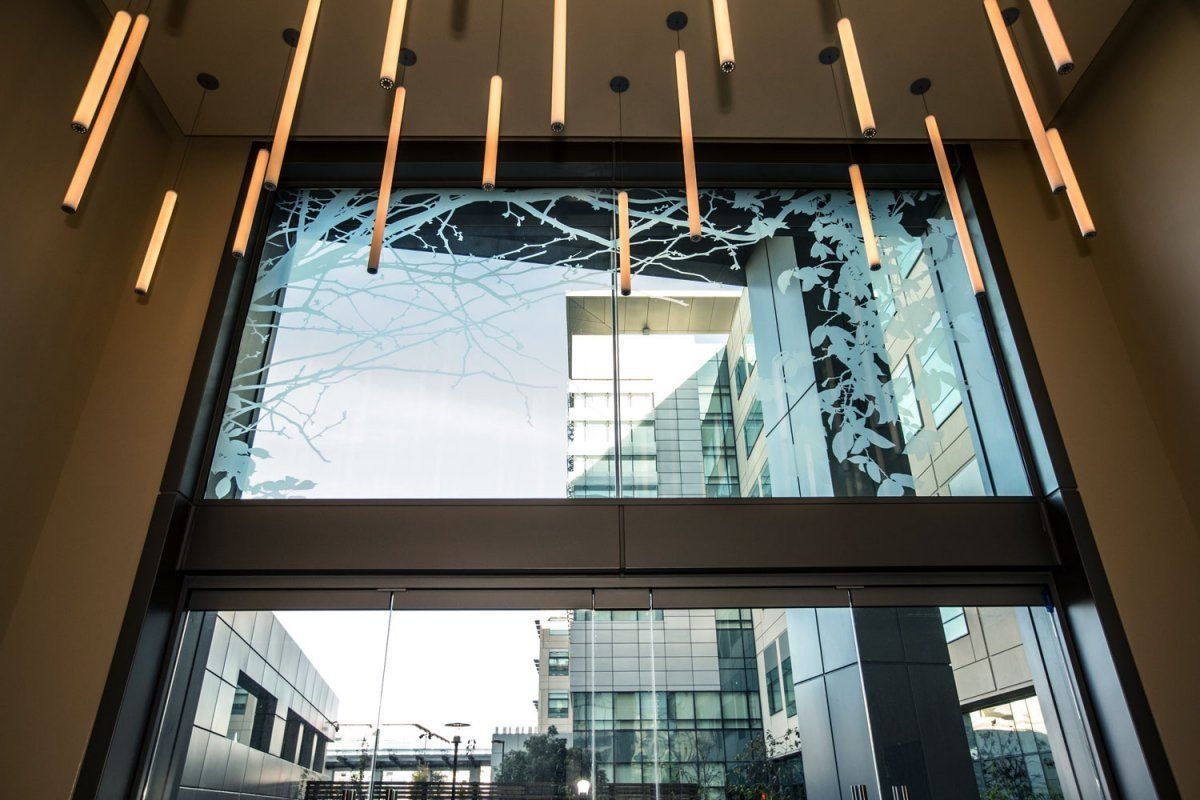
Brooklyn-based artist Mary Temple designed the Meditation Room, a tranquil space where people can meditate, pray or just enjoy the silence. Soft, shadowy tree branches etched into the glass window and paintings of light on the high walls direct visitors' gazes upward. Photo by Elisabeth Fall